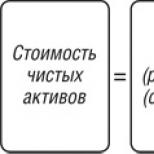The old New Year is celebrated. Old New Year: studying the history of the holiday. Where did this holiday come from?
What is the old New Year and why is it celebrated?On the night of January 13-14, the Old New Year is celebrated in Russia, as well as in many neighboring countries.
The Old New Year is a rare historical phenomenon, an additional holiday that resulted from a change in chronology. Because of this discrepancy in calendars, we celebrate two “New Years” - according to the old and new styles.
How did the Old New Year appear?
The date of creation of the world (according to the ancient translation of the Old Testament) was previously considered March 1, 5508 BC. e. Therefore, the New Year began on the first day of spring (March 14 according to the new style).
However, in the era of Constantinople, this date was recalculated more accurately, and September 1, 5509 BC was considered the day of the creation of the world. e. Therefore, the New Year henceforth began on the first day of autumn.
In pagan times in Rus', the New Year was celebrated on March 22 - the day of the spring equinox. After the adoption of Christianity in Rus', the Byzantine calendar began to gradually replace the old one, and the New Year now began on September 1. This date is still interpreted today by some teachings as the true birthday of Christ. D For a long time, New Year's inconsistency persisted in Rus' - some continued to celebrate the New Year in the spring, others in the fall. And only at the end of the 15th century - in 1492 - was a single date for the beginning of the New Year in Rus' officially determined - September 1.
Only 2 centuries later, on December 19, 1700, Peter I promulgated the decree of summer to be calculated from January 1 from the Nativity of Christ (that is, according to the “new” style - January 14). Thus, in the Russian state, 1699 lasted only 4 months, from September to December.
By the twentieth century, the calendar of Russia, which continued to use the Julian calendar, was 13 days behind Europe, which had long ago switched to the Gregorian calendar. To reduce this gap, in 1918, by decree of the Council of People's Commissars, a transition was made to the Gregorian calendar - a new style, and January 14 - the day of St. Basil, Archbishop of Caesarea of Cappodacia - turned out to be the Old New Year.
What other countries celebrate the Old New Year?
The Old New Year is celebrated not only in the CIS. On January 13, a festive table is also set in the following countries:
- Greece;
- Macedonia;
- Romania;
- Serbia;
- Montenegro;
- Switzerland.
The Old New Year is also celebrated in Algeria, Morocco and Tunisia. True, it is celebrated according to the Berber calendar, which is the Julian calendar with minor differences. As a result of accumulated errors, the eve of the holiday falls on January 11th.
Old New Year today
On the night of January 13-14, everyone can afford to “pre-celebrate” their most favorite holiday. Indeed, for many believers, the Old New Year has a special meaning, since they can wholeheartedly celebrate the beginning of the new year only after the end of the Nativity Fast.
Today, the popularity of the Old New Year is growing from year to year, and Russia is no exception. More and more people treat it as an independent holiday, which prolongs the charm of the New Year or allows them to feel this charm for the first time. After all, this holiday is calmer, it is not characterized by the bustle that is an inevitable companion of the New Year.
When will New Year be celebrated in 90 years?
Interestingly, the difference between the Julian and Gregorian calendars increases every century when the number of hundreds in the year after Christ is not a multiple of four for one day. Currently, the difference between the Julian and Gregorian calendars is 13 days. And from March 1, 2100, this difference will be 14 days. And from 2101, Christmas and Old New Year will be celebrated a day later.
It would seem that the contradictory and meaningless combination “old New Year” has become so familiar that it surprises no one and rarely makes one think. However, in moments of philosophical mood, questions begin to arise in your head: what is the Old New Year, why is the New Year celebrated twice in a number of countries, and where did this unusual folk holiday come from?
How the New Year appeared on the calendar
Celebrating the New Year on January 1 in the Russian Empire began only in 1700. Before this, there was no organization - the New Year was celebrated throughout the country on different dates. Some continued to do this in March on the day of the vernal equinox, and others on September 1, the date adopted in the state in the 15th century.
The initiator of the introduction of a single day at the beginning of the year was the founder of many innovations - Peter the Great. By decree of the sovereign, it was ordered to establish January 1 as the first day of the year and to celebrate this day festively, congratulating all loved ones and just people we met. The king commanded people to decorate Christmas trees, give each other gifts, have fun and rejoice. The decree also stated that during the New Year holidays people should not abuse strong drinks and not commit massacres.
Of course, such a strict framework initially caused indignation among the people, but after a whole week was declared non-working, residents of large and small cities calmed down and quickly fell in love with the new holiday. At night, in honor of the beginning of the new year, bonfires were lit, fireworks were displayed, songs were sung, and musical instruments were played.
By the way, the custom of decorating a Christmas tree was borrowed from the pagans. Ancient people decorated coniferous trees on the longest night of the year. They hung gifts and ribbons on spruce branches, trying to appease the spirits and beg them for a good harvest, prosperity and health. The cheerful tradition of dressing up in carnival costumes also has these same roots - pagans changed their image in order to hide from the evil forces descending on the earth on New Year's Eve.
Why did New Year's Day change?
The shift in the date of the beginning of the year in Russia occurred due to the transition from the Julian calendar to the Gregorian calendar after the revolution. The difference between the two calendars is 13 days - exactly the same amount of time that passes from the day of the official New Year celebration to New Year's Eve according to the old style.
Perhaps the transition to a new calendar would forever change the start date of the year, and no one would remember that it was once celebrated on a different day. However, the Russian Orthodox Church opposed the transition to the new chronology adopted by the Bolsheviks in 1918, and continued to live according to the Julian style. For this reason, all church holidays and important dates have been shifted.
Traditions in modern times
The Old New Year becomes more and more popular every decade. Of course, this holiday is not on the calendar, and it is unlikely that it will ever appear on it, but people gather on the night of January 13-14 at a set table, give each other gifts, make toasts and congratulations. In many houses, decorated Christmas trees and festive decorations are not removed until the Old New Year. On television that night, repeats of New Year's programs and traditional films are broadcast.
Christians who adhere to the Nativity Fast cannot afford festive dishes on New Year's Eve in the modern style. For them, the Old New Year is the only chance to set a delicious table with delicious snacks and meat dishes.
According to church customs, a special porridge is cooked on this night. All family members take part in the preparation, and in the morning it is eaten for breakfast at the common table. This custom, as well as visiting guests on New Year’s Eve, came from the ancient Russian calendar, when Vasily’s Day was celebrated on this date.
It is interesting that the New Year's date according to the Julian calendar in a century that is not a multiple of four is postponed by one day. Based on this, from 2101 New Year's Eve according to the old style will have to shift to January 14. Whether such a shift will occur among the people, and when people will celebrate the second New Year, time will tell.
Which countries celebrate the Old New Year?
Some are sure that the tradition of celebrating the New Year in the old style exists only in Russia and the Slavic countries that were part of the Soviet state. This is actually a misconception. The Old New Year is celebrated magnificently not only in Belarus, Ukraine and Moldova, it is adored in Serbia, Montenegro, Macedonia, Switzerland, Georgia and Armenia. Some residents of the Baltic countries, Azerbaijan, Kazakhstan and Uzbekistan do not forget to celebrate the beginning of the new year according to the Julian calendar.
The Berber calendar, followed by residents of Morocco, Tunisia, Algeria and some other countries, celebrates the beginning of the new year on January 14th. It is known that their calendar is in many ways similar to the Julian calendar, but is slightly shifted due to errors accumulated over many years.
On the night of January 13-14, we will celebrate the Old New Year - a holiday completely incomprehensible to most foreigners. However, since ancient times we have been accustomed to celebrating the Old New Year in a magnificent manner, observing many New Year traditions and rituals, conducting New Year fortune telling and eating dumplings with predictions.
What is Old New Year?
No one can really say how the Old New Year actually differs from the New Traditional Year, familiar to everyone? Of course, from the outside it seems that the matter is solely due to the discrepancy in dates. However, oddly enough, we all treat the Old New Year as a completely independent holiday that can prolong the charm of the New Year for us. For some, it is on this day that they finally manage to truly feel it. After all, the Old New Year is a calmer, family holiday, without the fuss and incredible hassle typical of the January 1 holiday.
One way or another, there are two reasons for the appearance of this unique Old New Year - a change in the date of the New Year on the territory of Rus' and the incredible stubbornness and unwillingness of the Russian Orthodox Church to switch to the New style of chronology.
But, despite the banality of the reasons, many people endow these dates with a hidden meaning, placing high hopes and believing in the deep mystery of the holiday. Do these dates carry any mysterious, mystical meaning? Let's figure it out.
The history of the Old New Year
In pagan times in Rus', the New Year was celebrated on March 22 - a very logical date, given that this is the day of the vernal equinox, closely associated with the agricultural cycle. After the adoption of Christianity in Rus', the Byzantine calendar began to gradually replace the old one, according to which the New Year now began on September 1. This date is still interpreted today by some teachings as the true birthday of Christ. For a long time, New Year's inconsistency persisted in Rus' - some continued to celebrate the New Year in the spring, others in the fall. And only at the end of the 15th century they officially determined a single date for the beginning of the New Year in Rus' - September 1.In 1699, by decree of the famous innovator, Peter I, the beginning of the New Year was moved to January 1, then according to the old style of chronology, therefore, according to the new style to January 14. And finally, in 1918, after the Great October Revolution, the Bolsheviks “abolished” the difference between the European and our chronology, “advancing” the calendar by 13 days a year.
This is how two New Year holidays were formed: one according to the new style, the other according to the old one, respectively New - on January 1 and Old New - on the 14th.
Opinion of the Christian Church about the Old New Year
The Russian Orthodox Church still celebrates the New Year today, as well as the Nativity of Christ, according to the old Julian calendar, which currently differs from the Gregorian calendar generally accepted in the world by those same 13 days. That is, on the night of January 13 to 14 we celebrate the Old New Year, and the church simply celebrates the New Year.An interesting fact in this matter is that the difference in dates from 2100, namely from March 1, will be not 13, but already 14 days. Since 2101, we will celebrate both the Old New Year and Christmas a day later. That is, the Old New Year is on the night from January 14 to the 15th, and Christmas is on January 8.
According to statements of the Russian Orthodox Church, they do not intend to make any adjustments to their calendar, since they do not see any sense in this. The difference between the Julian and Gregorian calendars actually increases by one day every 100 years. However, according to the church, it is not worth attaching much importance to calendar differences. The Gregorian calendar is also not accurate and has its shifts, so the Russian Orthodox Church continues to use the Julian calendar. Consent in calendar disputes can only be brought about by the development of a new, absolutely accurate calendar, which is practically impossible.
There is also a completely everyday explanation for church stubbornness. The fact is that for most believers, the Old New Year really has a special meaning, because they can celebrate it from the heart only after the Nativity Fast ends, during the Yuletide festivities.
Scientists about the Old New Year
January 14 is an unscientific date, astronomers say. However, the current calendar is not ideal. According to scientists, the mechanics of planetary motion is “to blame” for the need to make some changes to the chronology. The Julian calendar, which was in force in our country until 1918, lags behind the currently valid Gregorian calendar by 13 days.
The whole point is that planet Earth does not rotate around its axis in exactly 24 hours. Every day, additional seconds accumulate to this time, which gradually add up to days. They formed these 13 days by the beginning of the twentieth century, which make up the difference between the new Gregorian and old Julian systems. However, it should be noted that the new style is more accurate regarding the laws of astronomy.
The main thing, according to scientists, is that the calendar, whatever it may be, reflects as accurately as possible the location of our planet in relation to the Sun. Many enthusiasts today are trying to solve the calendar problem, and offer a lot of their own options for counting time. Applications to change the calendar chronology are received by the “tons” even to the UN. For the most part, these proposals are based on changes to the traditional week, for example, some propose introducing a five-day week or doing without weeks altogether, replacing them with ten days. However, ideal proposals that comply with the laws of astronomy and solve the problem of chronology, perhaps, cannot exist - this is precisely the conclusion that experts from many countries have come to. Scientists have come to the conclusion that it is inappropriate to carry out any calendar reforms at this stage.
Is Old New Year necessary?
But, no matter what scientists say, and even despite the fact that this day, unfortunately, is not even a day off, the popularity of this holiday is growing uncontrollably. According to some public opinion research centers, the number of people wishing to celebrate it in Russia has long exceeded 60%; in Ukraine it is even more – about 80% of the population. Moreover, among those who regularly celebrate or plan to celebrate the Old New Year, there are people with completely different statuses, incomes and ages: students, workers, entrepreneurs, housewives, with secondary specialized and higher education, pensioners...
The whole point, I think, is that, unlike Europeans, we have strong New Year traditions. We have something to do both for the New and Old New Year, and for the Christmas holidays and Christmas festivities... The breadth of our Slavic soul will not allow us to get bored. To be honest, we don’t really need a reason, but here it is! Let's go for a walk!
The Old New Year is a holiday that is incomprehensible to foreigners. And not every modern Russian is able to explain how this celebration actually differs from the traditional one, celebrated on the first day of January. Despite the fact that the difference between the holidays is only in the discrepancy in dates, we continue to celebrate the Old New Year, which gives many pleasant emotions. Now it is perceived as a continuation of the usual, when everyone can afford to continue celebrating their favorite holiday on the night of January 14th.
history of the holiday
Previously, the New Year in Rus' was celebrated on March 22, which had a direct connection with agriculture. When Christianity was adopted, the Byzantine calendar began to gradually replace the old one, and the holiday moved to the first day of September. Peter I decided to eliminate the confusion by moving the celebration to January 1 according to the old style. In this form it existed until the Bolsheviks came to power, who decided to change the chronology system. In 1918, the Soviet government decided to switch from the Julian to the Gregorian calendar. The Old Style New Year moved to January 14, which led to the emergence of a new holiday.
One of the reasons why the celebration was not quickly forgotten is due to the stubbornness of the Russian Orthodox Church, which continues to celebrate all such events according to the Julian calendar. However, this insistence is in fact not very justified precisely because even clergy should keep up with the times.
Now the clergy say that they do not intend to change their traditions, and calendar differences should not be given much importance. They refer to statements by astronomers who claim that the current calendar is also not ideal, and people will repeatedly make changes to the chronology system.
The Old New Year is another reason to get together with the whole family, congratulate friends and loved ones, give beautiful gifts and, of course, believe in a miracle. This winter holiday is celebrated in our country on the night of January 13-14 and completes a series of New Year celebrations. But is the Old New Year only in Russia? And in general, why did such an unusual holiday arise? We are sure that many of our readers have asked this question more than once on the eve of the winter holidays.
Usually the Old New Year falls on the first working week after a multi-day rest. But how great it is to watch New Year’s films again, cook “herring under a fur coat” and invite guests! We owe such a wonderful opportunity to an amazing phenomenon. Want to know which one? Read about it in our new article!
How did the holiday come about?
In Rus', in the distant times of paganism, our ancestors celebrated the New Year on March 22 - the day of the spring solstice. After Prince Vladimir adopted the Christian faith in 988, this holiday began to be celebrated on September 1. According to the Old Testament, this date corresponds to the first day of the creation of the world.
For many centuries there was no consensus on the celebration of the New Year: some celebrated it in the fall, while others continued to adhere to the pagan calendar. But in 1492 the discrepancies were put to an end, and the New Year was officially celebrated on September 1.
However, this date did not last long: after just a couple of centuries, Peter I moved our favorite holiday to January 1 from the Nativity of Christ, since the emperor did not want to be behind enlightened Europe. This decree was issued on December 19, 1699, so the current year was only four months: September, October, November and December. Since then, residents of Russia began to celebrate the New Year on January 1, as we do today.
But where did the 14th come from then? Here we come to the solution. The thing is that before the revolution it was used Julian "old" calendar. The difference between it and the “new” Gregorian calendar, according to which Europe had long lived, was as much as 13 days.
After the October Revolution and the advent of Soviet power, Christmas was canceled due to its religiosity, and a year later the Bolsheviks decided that Soviet Russia would switch to a new calendar. Thus, the difference in the calendars was eliminated, and January 14, which used to be New Year's Day, coincided with St. Basil's Day. This is how two holidays began to be celebrated in our country.
It is noteworthy that after the collapse of the Soviet Union, Christmas continued to be celebrated on January 7, which corresponds to the Julian “old” style, so the date of this religious holiday is connected specifically with the Old New Year.
Old New Year in other countries
The night from January 13 to 14 became a holiday not only for the former countries of the Soviet Union - the CIS countries, but also for some others: Switzerland, Greece, Montenegro, Romania, Serbia and Macedonia. And this is still an incomplete list.
Such a holiday as the “Old New Year” exists among states that used the Berber chronology before the introduction of the Gregorian calendar. In fact, it differs slightly from the Julian, but due to some errors and errors, the eve of the Old New Year in Tunisia, Morocco and Algeria is celebrated on January 11.
Our days
For many people in our country who profess Orthodoxy, there is only one holiday - the Old New Year, because until Christmas they observe the Nativity Fast. For everyone else, this is an opportunity to once again celebrate their favorite holiday and feel the atmosphere of magic: how you want to meet Santa Claus again and find a treasured gift under the tree!
These days this holiday is becoming increasingly popular. Its special charm is associated with pre-revolutionary Russia, Orthodox traditions, and simply popular love for the New Year. This celebration has even partially become independent, because it has its own history of origin. In addition, by the end of the holidays, the pre-holiday bustle subsides, and the Old New Year can be enjoyed in a quiet family circle.

Our little historical journey has come to an end. We hope that you have learned a lot of interesting things, and now you have no doubt why the Old New Year is celebrated on January 14. Perhaps we should be grateful to this unusual historical phenomenon for the fact that we have another chance to happily celebrate the New Year and believe in a winter fairy tale.





